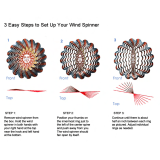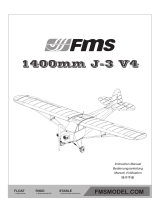
EN
14
Night Timber X 1.2m
Flying Tips and Repairs
Consult local laws and ordinances before choosing a ying location.
Range Check your Radio System
Before you y, range check the radio system. Refer to your speci c transmitter
instruction manual for range test information.
Oscillation
Once the AS3X system is active (after advancing the throttle for the rst time),
you will normally see the control surfaces react to aircraft movement. In some
ight conditions you may see oscillation (the aircraft rocks back and forth on
one axis due to overcontrol). If oscillation occurs, refer to the Troubleshooting
Guide for more information.
Takeoff
Place the aircraft facing into the wind. Set your transmitter in low rate and
use your aps switch to drop the aps to takeoff or “half position”. Gradually
increase the throttle to ¾ and steer with the rudder. Flaps make takeoffs
shorter. As the plane reaches ying speed, pull back gently on the elevator.
When airborne, climb to a comfortable altitude and then ip your aps switch
to level the aps.
Flying
For your rst ights with the recommended battery pack (SPMX22004S30), set
your transmitter timer or a stopwatch to 4 minutes. After four minutes, land the
aircraft. Adjust your timer for longer or shorter ights once you have own the
model. If at any time the motor power reduces, land the aircraft immediately to
recharge the ight battery. See the Low Voltage Cutoff (LVC) section for more
details on maximizing battery health and run time.
Landing
Land the aircraft into the wind. Use a small amount of throttle for the entire
descent. Lower the throttle to ¼ and ip your aps switch to deploy the aps
to the landing or “full down position”. Flaps will make the landing approach
steeper and slower, and allow for a smoother landing.
Keep the throttle on until the aircraft is ready to are. During are, keep the
wings level and the aircraft pointed into the wind. Gently lower the throttle
while pulling back on the elevator to bring the aircraft down on its wheels.
If landing on grass, it is best to hold full up elevator after touchdown and when
taxiing to prevent the nose from digging in.
Once on the ground, avoid sharp turns until the plane has slowed enough to
prevent scraping the wingtips.
NOTICE: If a crash is imminent, reduce the throttle and trim fully. Failure to
do so could result in extra damage to the airframe, as well as damage to the
ESC and motor.
NOTICE: After any impact, always ensure the
receiver is secure in the fuselage. If you replace
the receiver, install the new receiver in the
same orientation as the original receiver or
damage may result.
NOTICE: Crash damage is not covered under
warranty.
NOTICE: When you are nished ying, never
leave the aircraft in direct sunlight or in a hot,
enclosed area such as a car. Doing so can
damage the aircraft.
Water Takeoff and Landing Using the
Optional Float Set
Only use the oats if you are comfortable ying your aircraft and have repeatedly
taken off, own and landed with success. Flying off water poses a higher risk to
the airplane because the electronics can fail if fully immersed in water.
Always ensure the optional oats are secure on the fuselage and that the oat
dual rudder system is correctly connected and moves freely before putting the
aircraft in water.
To take off on water, steer with the rudder and slowly increase the throttle.
Keep the wings level on takeoff. Hold a small amount (1/4–1/3) of up elevator
and the aircraft will lift off once ying speed is reached.
To land this aircraft on water, y the aircraft to a couple of feet off the surface
of the water. Reduce throttle and add up elevator to are the aircraft.
When taxiing, you must use throttle to move the aircraft forward, but steer
with the rudder stick. The stick will turn both the aircraft rudder and the small
rudders attached to the oats.
Avoid taxiing cross wind if there is a breeze, as this can cause the aircraft to
ip over if wind gets under the upwind wing. Taxi 45 degrees into the direction
of the wind (not perpendicular to the wind) and use aileron to hold the upwind
wing down. The aircraft will naturally try to face into the wind when taxiing.
Always fully dry the aircraft after landing on water.
CAUTION: Never go alone to get a downed model in the water.
CAUTION: If at any time water splashes in the fuselage while ying
from water, bring the airplane to shore, open the battery hatch and
immediately remove any water that may have gotten in the fuselage. Leave
the battery hatch open overnight to let the inside dry out and to prevent
moisture damage to the electronic components. Failure to do so could cause
the electronic components to fail, which could result in a crash.
Low Voltage Cutoff (LVC)
When a Li-Po battery is discharged below 3V per cell, it will not hold a charge.
The ESC protects the ight battery from over-discharge using Low Voltage
Cutoff (LVC). Before the battery charge decreases too much, LVC removes
power supplied to the motor. Power to the motor reduces, showing that some
battery power is reserved for ight control and safe landing.
Disconnect and remove the Li-Po battery from the aircraft after use to prevent
trickle discharge. Charge your Li-Po battery to about half capacity before
storage. During storage, make sure the battery charge does not fall below 3V
per cell. LVC does not prevent the battery from over-discharge during storage.
NOTICE: Repeated ying to LVC will damage the battery.
Tip: Monitor your aircraft battery’s voltage before and after ying by using a
Li-Po Cell Voltage Checker (EFLA111, sold separately).
Repairs
Thanks to the EPO foam material in this aircraft, repairs to the foam can be
made using virtually any adhesive (hot glue, regular CA, epoxy, etc). When parts
are not repairable, see the Replacement Parts List for ordering by item number.
For a listing of all replacement and optional parts, refer to the list at the end of
this manual.
NOTICE: Use of CA accelerant on your aircraft can damage paint. DO NOT
handle the aircraft until accelerant fully dries.
WARNING: Always
decrease throttle
at propeller strike.
45º
Up Aileron
Down Aileron
Wind
Taxi 45 degrees into the direction of the wind.





















